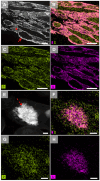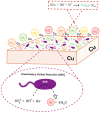Insights into the Impact of Physicochemical and Microbiological Parameters on the Safety Performance of Deep Geological Repositories
- PMID: 38792854
- PMCID: PMC11123828
- DOI: 10.3390/microorganisms12051025
Insights into the Impact of Physicochemical and Microbiological Parameters on the Safety Performance of Deep Geological Repositories
Abstract
Currently, the production of radioactive waste from nuclear industries is increasing, leading to the development of reliable containment strategies. The deep geological repository (DGR) concept has emerged as a suitable storage solution, involving the underground emplacement of nuclear waste within stable geological formations. Bentonite clay, known for its exceptional properties, serves as a critical artificial barrier in the DGR system. Recent studies have suggested the stability of bentonite within DGR relevant conditions, indicating its potential to enhance the long-term safety performance of the repository. On the other hand, due to its high resistance to corrosion, copper is one of the most studied reference materials for canisters. This review provides a comprehensive perspective on the influence of nuclear waste conditions on the characteristics and properties of DGR engineered barriers. This paper outlines how evolving physico-chemical parameters (e.g., temperature, radiation) in a nuclear repository may impact these barriers over the lifespan of a repository and emphasizes the significance of understanding the impact of microbial processes, especially in the event of radionuclide leakage (e.g., U, Se) or canister corrosion. Therefore, this review aims to address the long-term safety of future DGRs, which is critical given the complexity of such future systems.
Keywords: bentonite; compaction; corrosion; deep geological repository; microorganism; nuclear waste; radiation; temperature.
Conflict of interest statement
The authors declare no conflicts of interest.
Figures





Similar articles
-
Microbial responses to elevated temperature: Evaluating bentonite mineralogy and copper canister corrosion within the long-term stability of deep geological repositories of nuclear waste.Sci Total Environ. 2024 Mar 10;915:170149. doi: 10.1016/j.scitotenv.2024.170149. Epub 2024 Jan 17. Sci Total Environ. 2024. PMID: 38242445
-
Impact of compacted bentonite microbial community on the clay mineralogy and copper canister corrosion: a multidisciplinary approach in view of a safe Deep Geological Repository of nuclear wastes.J Hazard Mater. 2023 Sep 15;458:131940. doi: 10.1016/j.jhazmat.2023.131940. Epub 2023 Jun 26. J Hazard Mater. 2023. PMID: 37390682
-
Exploring the governing transport mechanisms of corrosive agents in a Canadian deep geological repository.Sci Total Environ. 2022 Jul 1;828:153944. doi: 10.1016/j.scitotenv.2022.153944. Epub 2022 Feb 19. Sci Total Environ. 2022. PMID: 35192826
-
Impact of microbial processes on the safety of deep geological repositories for radioactive waste.Front Microbiol. 2023 Mar 16;14:1134078. doi: 10.3389/fmicb.2023.1134078. eCollection 2023. Front Microbiol. 2023. PMID: 37007474 Free PMC article. Review.
-
Investigating the Potential Barrier Function of Nanostructured Materials Formed in Engineered Barrier Systems (EBS) Designed for Nuclear Waste Isolation.Chem Rec. 2018 Jul;18(7-8):1065-1075. doi: 10.1002/tcr.201700094. Epub 2018 Feb 21. Chem Rec. 2018. PMID: 29465808 Review.
References
-
- International Atomic Energy Agency (IAEA) Status and Trends in Spent Fuel and Radioactive Waste Management. International Atomic Energy Agency; Vienna, Austria: 2022. [(accessed on 1 January 2022)]. (Nuclear Energy Series No. NW-T-1.14). Available online: https://www-pub.iaea.org/MTCD/Publications/PDF/PUB1963_web.pdf.
-
- Xu Y., Zeng Z., Lv H. Temperature dependence of apparent thermal conductivity of compacted bentonites as buffer material for high-level radioactive waste repository. Appl. Clay Sci. 2019;174:10–14. doi: 10.1016/j.clay.2019.03.017. - DOI
-
- Bajestani M.S., Nasir O., Oh W.T. Properties of Bentonite-Based Sealing Materials during Hydration. Minerals. 2023;13:1412. doi: 10.3390/min13111412. - DOI
-
- García-Romero E., María Manchado E., Suárez M., García-Rivas J. Spanish bentonites: A review and new data on their geology, mineralogy, and crystal chemistry. Minerals. 2019;9:696. doi: 10.3390/min9110696. - DOI
-
- Stroes-Gascoyne S., Hamon C.J., Maak P., Russell S. The effects of the physical properties of highly compacted smectitic clay (bentonite) on the culturability of indigenous microorganisms. Appl. Clay Sci. 2010;47:155–162. doi: 10.1016/J.CLAY.2008.06.010. - DOI
Publication types
Grants and funding
LinkOut - more resources
Full Text Sources

